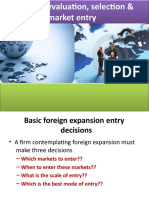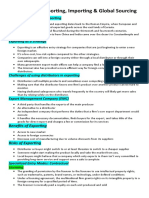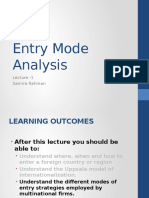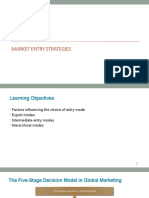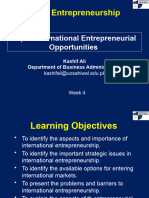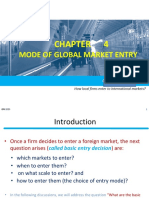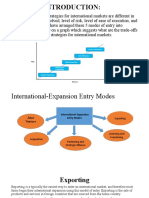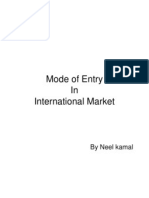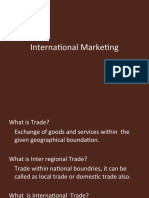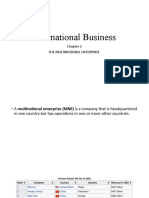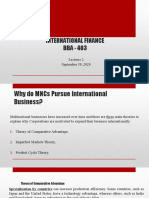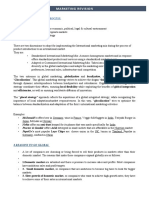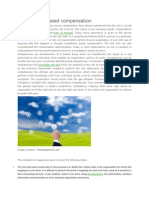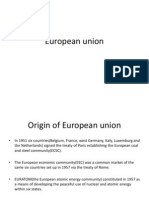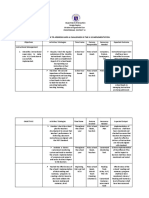Models of Internalisation
Models of Internalisation
Uploaded by
Harshini SandadiCopyright:
Available Formats
Models of Internalisation
Models of Internalisation
Uploaded by
Harshini SandadiOriginal Description:
Original Title
Copyright
Available Formats
Share this document
Did you find this document useful?
Is this content inappropriate?
Copyright:
Available Formats
Models of Internalisation
Models of Internalisation
Uploaded by
Harshini SandadiCopyright:
Available Formats
Entry Modes
Modes of entering
International Business
Pioneers vs. Fast Followers
Pioneers
Can gain and maintain
competitive edge in new
market
Overall pioneers may not
perform as well in the long
run as followers
Most successful when
High entry barriers exist
Firm has sufficient size,
resources, and
competencies
Followers
Many become followers
by default
May be advantage to let
pioneer take initial risks
Most successful when
Few legal, technological,
cultural, or financial
barriers
Sufficient resources or
competencies to
overwhelm the pioneers
early advantage
Entering Foreign Markets
Nonequity modes of market entry
Exporting
Selling some regular production overseas
Requires little investment
Relatively free of risk
Indirect exporting
Direct exporting
Equity modes of market entry
Wholly owned subsidiary
Joint venture
Strategic alliance
Summary: Modes of Entry
Exporting - Indirect Exporting
Exporting of goods and services through various home-based
exporters
Manufacturers export agents
sell for manufacturer
Export commission agents
buy for overseas customers
Export merchants
purchase and sell for own accounts
International firms
use the goods overseas
Indirect Exporting, contd.
Disadvantages
Commission to export agents, commission agents, export
merchants
Foreign business can be lost if exporters decide to change
their sources and supply
Firm gains little experience from transactions
Direct Exporting
Exporting of goods and services by the producing firm
Sales company option
Business established to market goods and services
Internet has made direct exporting much easier
Cost of trial low
Exporting
Turnkey Project used for export of
Technology
Management expertise
Capital equipment (some cases)
After trial run, facility is turned over to purchaser
Exporter of a turnkey project may be
Contractor that specializes in designing and erecting plants in
a particular industry
Company that wishes to earn money from its expertise
Producer of a factory
Exporting, contd
Licensing
A contractual arrangement: one firm sells access to its patents,
trade secrets, or technology to another
Licensee pays fixed sum and sales royalties (2%-5%)
Popular because
Courts have begun upholding patent infringement claims
Patent holders have become vigilant in suing violators
Foreign governments have been pressed to enforce their
patent laws
Issues in International Licensing
Under international licensing manufacturer leases the right to use
intellectual property to a manufacturer in a foreign country for a fee.
Boundaries of the agreements
Determination of royalty
Determining rights, privileges and constraints
Dispute settlement mechanism
Agreement duration
16-10
Franchising
Franchising
Form of licensing in which one firm contracts with another to
operate a certain type of business under an established name
according to specific rules.
Basic issues in Franchising
- franchising agreements
1. Franchisee has to pay a fixed amount and royalty based on sales
2. Agree to adhere to follow the franchisors requirements; appearance, financial
reporting, operating procedure, customer service etc.
3. Establishing manufacturing facilities, services facilities, provides expertise,
advertising, corporate image etc
4. But some degree of flexibility in order to meet the local tastes and preferences.
Ex: McDonald, Dominos, Pizza Hut, KFC etc
Contracts
Management Contract
Arrangement by which one firm provides management in all or
specific areas to another firm
Ex: Delta, Air France and KLM often provide technical and
managerial assistance to the small airlines companies owned
by govt.
Contract Manufacturing
Arrangement in which one firm contracts with another to
produce products to its specifications but assumes
responsibility for marketing. Ex: Nike with factories in south-
east Asia to Athletic footware; Bata with cobblers in India.
Business Process Outsourcing
Turnkey Project
It is a contract under which a firm agrees to fully design, construct
and equip a manufacturing/business/service facility and turn the
project over to the purchaser when it is ready for operation for a
remuneration.
It includes: a fixed price or payment on cost plus basis.
So shifts the risk of inflation/enhanced costs to the purchaser.
Ex: International turnkey projects include nuclear power, air ports,
oil refinery, national highways, railways etc.
16-13
Equity-Based Modes of Entry
Wholly Owned Subsidiary or Foreign Direct Investment without
Alliances
Joint Venture
Strategic Alliance
Wholly Owned Subsidiary
Wholly Owned Subsidiary
build a new plant (greenfield strategy). It refers to starting
of the operations of a company from scratch in a foreign
market.
Ex: Fuji manufacturing unit in South Carolina, Nissan
factory in Sunderland, England
Joint Venture
Joint Venture
Cooperative effort among two or more organizations that
share common interest in business enterprise
corporate entity formed by international company and local
owners
corporate entity formed by two international companies for
the purpose of doing business in a third market
a corporate entity formed by a government
Joint Venture, contd.
Disadvantages
Profits shared
If law allows no more than 49% foreign ownership, lose
control
Control with minority ownership is possible if
Take 49% of shares and give 2% to local law firm or
trusted national
Take in local majority partner (sleeping partner)
Management contract
Can enable the global partner to control many aspects
of a joint venture even when holding only a minority
position
Strategic Alliances
Partnerships between competitor, customers, or suppliers that
may take various forms
Aims to achieve
Faster market entry and start-up
Access to new
Products
Technologies
Markets
Cost-savings by sharing
Costs
Resources
Risks
Ex: Xerox of USA and Fuji of Japan to explore new markets in
Europe and Pacific Rim.
Strategic Alliances, contd.
May be Joint Ventures
Pooling alliances driven by
similarity and integration
Trading alliances driven by
contribution of dissimilar
resources
Alternatives to mergers and
acquisitions
Future of Alliances
Many fail or are taken
over by a partner
Difficult to manage
Different strategies
Different operating
practices
Different
organizational cultures
Allow partner to acquire
technological or other
competencies
Regardless, will continue
to be important strategic
tool
Channel of Distribution
Links producer with foreign user
Product and its title pass from producer to user
Channel of Distribution Members:
Indirect Exporting
Indirect Export Channel Members
Sell for manufacturer
Buy for overseas customers
Buy and sell for own account
Purchase on behalf of foreign middlemen or users
Indirect Exporting
Exporters that sell for the manufacturer
Manufacturers export agent
Acts as the international representative for various
noncompeting domestic manufacturers
Export management companies (EMC)
Acts as the export department for noncompeting
manufacturers
International trading companies
Acts as agent for some companies and as wholesaler for
others
Indirect Exporting: International
Trading Companies
International Trading Companies
Japan: Sogo Shosha
Originally established by the zaibatsu, centralized, family-
dominated economic groups
Korean: chaebol
Owned by Korean conglomerates
Export trading companies (ETC)
U.S. firm established principally to export domestic goods and
services
International Channels of Distribution
Indirect Exporting, contd.
Exporters that buy for their overseas customers
Export commission agents
Represent overseas purchasers, such as import firms and
large industrial users
Paid commission by the purchaser for acting as resident
buyer
Indirect Exporting, contd.
Exporters that buy and sell for their own account
Export merchants
Purchase products directly from the manufacturer and
then sell, invoice, and ship them in their own names
Cooperative exporters/piggyback exporters
Established international manufacturers that export other
manufacturers goods as well as their own
Webb-Pomerene Associations
Organizations of competing firms that have joined together
for the sole purpose of export trade
Indirect Exporting, contd.
Exporters that purchase for foreign users and middlemen
Large foreign users
Buy for their own use overseas
Export resident buyers
Perform essentially the same functions as export
commission agents but more closely associated with a
foreign firm
Direct Exporting Distribution Channel
Members
Manufacturers agent
Independent sales representative of noncompeting suppliers
Distributor/wholesale importer
Independent importer that buys for own account for resale
Retailer
Frequently direct importer
Trading company
Firm that develops international trade and serves as
intermediary between foreign buyers and domestic sellers and
vice versa
You might also like
- (Download PDF) Food and Nutrition Sustainable Food and Health Systems 4Th Edition Mark L Wahlqvist Danielle Gallegos Online Ebook All Chapter PDFDocument42 pages(Download PDF) Food and Nutrition Sustainable Food and Health Systems 4Th Edition Mark L Wahlqvist Danielle Gallegos Online Ebook All Chapter PDFjames.king789100% (15)
- Stages of InternationalizationDocument28 pagesStages of Internationalizationpujaadi100% (4)
- Study Guide: Facilitate Elearning Sessions Online Training (40 Hours) Prepared byDocument9 pagesStudy Guide: Facilitate Elearning Sessions Online Training (40 Hours) Prepared byPaulAcademics100% (3)
- Module 2 - Classic Theories of Economic Growth and Development PPT - PDF - 2Document44 pagesModule 2 - Classic Theories of Economic Growth and Development PPT - PDF - 2Alyssa Alejandro50% (2)
- Learning Objectives: Welcome To Class of International Market Entry Modes Dr. Satyendra SinghDocument26 pagesLearning Objectives: Welcome To Class of International Market Entry Modes Dr. Satyendra Singhazar4dldNo ratings yet
- Chapter 8 Exp MKTDocument34 pagesChapter 8 Exp MKTmoonballlseNo ratings yet
- International Markets Entry StrategiesDocument58 pagesInternational Markets Entry StrategiesTania GhoshNo ratings yet
- Int - MRKT.CH - 3Document17 pagesInt - MRKT.CH - 3Ebsa AdemeNo ratings yet
- Foreign Market Entry StrategiesDocument48 pagesForeign Market Entry StrategiesHeta SanghaniNo ratings yet
- Modes of Entry Into Foreign MarketDocument25 pagesModes of Entry Into Foreign MarketYogesh BatraNo ratings yet
- Foreign Market Entry PPT NotsDocument41 pagesForeign Market Entry PPT NotsremojamwaNo ratings yet
- IB Modes of International Bussns ExpDocument61 pagesIB Modes of International Bussns ExpVanshaj KumarNo ratings yet
- Chapter 9 - Ba 423 NotesDocument7 pagesChapter 9 - Ba 423 NotesKhim NaulNo ratings yet
- Unit 1 3 Types and Forms of International BusinessDocument29 pagesUnit 1 3 Types and Forms of International BusinessKARCHISANJANANo ratings yet
- Foreign Market EntryDocument7 pagesForeign Market EntryMehulmaniar13No ratings yet
- INB 480 Entry Mode AnalysisDocument40 pagesINB 480 Entry Mode AnalysisAbraham ZeusNo ratings yet
- Market Entry & ExpansionDocument20 pagesMarket Entry & Expansionpriyanka atriNo ratings yet
- Foreign Market Entry PPT NotsDocument45 pagesForeign Market Entry PPT NotsremojamwaNo ratings yet
- MEC 35 - Chapter 9WDDocument25 pagesMEC 35 - Chapter 9WDANGELU RANE BAGARES INTOLNo ratings yet
- Entry StrategiesDocument35 pagesEntry StrategiesNakul GautamNo ratings yet
- Chap 012 MsDocument30 pagesChap 012 MsQuỳnh PhươngNo ratings yet
- Chapter 1Document6 pagesChapter 1jatin_singhal_2No ratings yet
- Unit 2 Global Business Bba NotesDocument59 pagesUnit 2 Global Business Bba NotesHome PCNo ratings yet
- Entering Foreign Markets - MidtermDocument22 pagesEntering Foreign Markets - Midtermnatalie clyde matesNo ratings yet
- Chapter 8Document21 pagesChapter 8SadiqSagheerNo ratings yet
- Session 3 Modes of International BusinessDocument40 pagesSession 3 Modes of International Businessbrownpie2019No ratings yet
- Foreign Market Entry StrategiesDocument48 pagesForeign Market Entry StrategiesAkshay RaturiNo ratings yet
- Market Entry StrategiesDocument30 pagesMarket Entry Strategiesiamrockrock7407No ratings yet
- Aarti IBnotesDocument49 pagesAarti IBnotesAnkita LalNo ratings yet
- Week 4 EntrepreneurshipDocument35 pagesWeek 4 EntrepreneurshipMuhammad AbuzarNo ratings yet
- DBI - Unit 2Document39 pagesDBI - Unit 2Mohit KhuranaNo ratings yet
- International Entry Modes: Shikha SharmaDocument32 pagesInternational Entry Modes: Shikha SharmashikhagrawalNo ratings yet
- Market Entry StrategyDocument9 pagesMarket Entry StrategyMaria SebastianNo ratings yet
- Entry Strategy and Strategic AlliancesDocument30 pagesEntry Strategy and Strategic AlliancesManju Honnur100% (2)
- Foreign Operation ModesDocument35 pagesForeign Operation ModesNicole Daniela Tacure CotrinaNo ratings yet
- SM Module 5Document13 pagesSM Module 5Eti Prince BajajNo ratings yet
- Chapter Three: International Business Entry StrategiesDocument47 pagesChapter Three: International Business Entry StrategieserkiyhunNo ratings yet
- Case: Diebold: Through Acquisitions Joint Ventures JDocument38 pagesCase: Diebold: Through Acquisitions Joint Ventures JsomnathmangarajNo ratings yet
- Modes of Entry Into International MarketingDocument14 pagesModes of Entry Into International Marketingvaishnavi sasidharanNo ratings yet
- Global Entry Strategies: Presented By: Aathira Ajith Roll No: 501 Sreeraj R Roll No: 558Document24 pagesGlobal Entry Strategies: Presented By: Aathira Ajith Roll No: 501 Sreeraj R Roll No: 558Sreeraj R NairNo ratings yet
- Chapter-2 0Document23 pagesChapter-2 0KIBRUNo ratings yet
- Chapter 4 Mode of Global Market EntryDocument27 pagesChapter 4 Mode of Global Market EntryAddiNo ratings yet
- Entry StrategiesDocument42 pagesEntry Strategiespriyanka_singhviNo ratings yet
- Entry ModesDocument30 pagesEntry ModesShweta SharmaNo ratings yet
- Chpater 15Document18 pagesChpater 15rittik sarkerNo ratings yet
- GB 3 QnsDocument17 pagesGB 3 QnsDinesh DinnuNo ratings yet
- Chapter Four SlideDocument88 pagesChapter Four SliderezikaabdulkadirNo ratings yet
- Global Market Entry Strategies and Internationalization ProcessDocument25 pagesGlobal Market Entry Strategies and Internationalization ProcessPrasad GantiNo ratings yet
- 421S10WebCh9 17x15slides060410Document121 pages421S10WebCh9 17x15slides060410Rahul KulkarniNo ratings yet
- Entry Strategy AND Strategic AlliancesDocument39 pagesEntry Strategy AND Strategic AlliancesClaire VillaceranNo ratings yet
- 2 International Entry ModesDocument13 pages2 International Entry ModesNguyen Dieu LinhNo ratings yet
- Mode of EntryDocument10 pagesMode of Entry2nehaNo ratings yet
- Globalization StrategiesDocument18 pagesGlobalization StrategiesHamza NawazNo ratings yet
- FDI As A Market Entry Strategy 1Document35 pagesFDI As A Market Entry Strategy 1jordanNo ratings yet
- Unit1 Inter MKTGDocument28 pagesUnit1 Inter MKTGJaved HussainNo ratings yet
- Multinational Corporations and Transnational CorporationsDocument24 pagesMultinational Corporations and Transnational Corporationsdynamo vjNo ratings yet
- International Business: The Multinational EnterpriseDocument33 pagesInternational Business: The Multinational Enterprisewaqas azamNo ratings yet
- Licensing, Franchising and Other Contractual Entry Strategies - Chapter 15Document16 pagesLicensing, Franchising and Other Contractual Entry Strategies - Chapter 15Bashar HassanNo ratings yet
- CH 4 PPTDocument40 pagesCH 4 PPTMekoninn HylemariamNo ratings yet
- International Finance BBA - 403: Lectures 2 September 30, 2020Document23 pagesInternational Finance BBA - 403: Lectures 2 September 30, 2020ifrah ahmadNo ratings yet
- 8 Reasons To Go GlobalDocument7 pages8 Reasons To Go GlobalMaryam Fellous MelnykNo ratings yet
- Competency Based CompensationDocument5 pagesCompetency Based CompensationHarshini SandadiNo ratings yet
- Incentive Wage PlansDocument5 pagesIncentive Wage PlansHarshini SandadiNo ratings yet
- InternalizationDocument8 pagesInternalizationHarshini SandadiNo ratings yet
- Case Study On Performance AppraisalDocument3 pagesCase Study On Performance AppraisalHarshini SandadiNo ratings yet
- European UnionDocument4 pagesEuropean UnionHarshini SandadiNo ratings yet
- Noti - Fire - Net™: Release 5.0Document4 pagesNoti - Fire - Net™: Release 5.0luisrruiz_123No ratings yet
- Study Guide - Exam 70-761Document20 pagesStudy Guide - Exam 70-761jelopezz100% (1)
- GS33J62F20 01enDocument8 pagesGS33J62F20 01enBobby SetiawanNo ratings yet
- Chapter 5 Utilization of Assessment ToolsDocument5 pagesChapter 5 Utilization of Assessment ToolsChristine Ivy Serrano100% (1)
- "Jiggle" ExcerptDocument6 pages"Jiggle" ExcerptHere & NowNo ratings yet
- 1LX100 SchematicDocument4 pages1LX100 Schematicab5951No ratings yet
- Study Report: Car Parks - Fires Involving Modern Cars and Stacking SystemsDocument108 pagesStudy Report: Car Parks - Fires Involving Modern Cars and Stacking SystemsBerkan KayadanNo ratings yet
- Electrical Safety Manual: University of Alabama Office of Environmental Health & Safety JUNE 2013Document39 pagesElectrical Safety Manual: University of Alabama Office of Environmental Health & Safety JUNE 2013Nur Syafiqah Mat RapieNo ratings yet
- PROS 6 ACTION PLAN To ADDRESS GAPS and CHALLENGES in The K 12 IMPLEMENTATIONDocument4 pagesPROS 6 ACTION PLAN To ADDRESS GAPS and CHALLENGES in The K 12 IMPLEMENTATIONJAY LAYNONo ratings yet
- 3 Approaches To DCDocument21 pages3 Approaches To DCSaurabhNo ratings yet
- Twitter Project FinalDocument44 pagesTwitter Project FinalJelloNo ratings yet
- Arithmetic ProgressionDocument85 pagesArithmetic ProgressionNilesh KumarNo ratings yet
- DSA Presentation Group 6Document34 pagesDSA Presentation Group 6AYUSHI WAKODENo ratings yet
- Livelihood Pattern Study of Communities Residing in Kanha-Pench CorridorDocument50 pagesLivelihood Pattern Study of Communities Residing in Kanha-Pench CorridorV VishalNo ratings yet
- CARBOHYDRATE ABSORPTION (Ref)Document22 pagesCARBOHYDRATE ABSORPTION (Ref)NEERAJA S RAJNo ratings yet
- The Importance of Soft SkillsDocument12 pagesThe Importance of Soft Skillsshindedattatri100% (1)
- Catalogo Motores Siemens PDFDocument176 pagesCatalogo Motores Siemens PDFgiovanni1912No ratings yet
- CHM510-e - LaboratoryManual Sem October 2020-Februari2021Document46 pagesCHM510-e - LaboratoryManual Sem October 2020-Februari2021Amirah AzlanNo ratings yet
- EURO4 TFT RetrofitDocument14 pagesEURO4 TFT RetrofitfarmaciapimpaoNo ratings yet
- Earth Science (SHS) Q2 Mod5 Rocksbehaviourunderrstress v2Document19 pagesEarth Science (SHS) Q2 Mod5 Rocksbehaviourunderrstress v2Roseman TumaliuanNo ratings yet
- Draft Resolution For Society-TrustDocument2 pagesDraft Resolution For Society-Trustammaiappar0% (2)
- Menu - Banquets From 01st May-22-1Document6 pagesMenu - Banquets From 01st May-22-1Ravi KanthNo ratings yet
- Electronic Dartboard Owner's Manual and Game InstructionsDocument17 pagesElectronic Dartboard Owner's Manual and Game InstructionsChu Chuito TachinNo ratings yet
- All What You Need To Know About POWL in SAP - SAP4TECHDocument6 pagesAll What You Need To Know About POWL in SAP - SAP4TECHBarun SahaNo ratings yet
- Listening Beyond The Echoes MediaDocument207 pagesListening Beyond The Echoes Mediab-b-b1230% (1)
- A8 Resistors in Series and ParallelDocument4 pagesA8 Resistors in Series and ParallelAndrei NicolasNo ratings yet
- Oil Mill Machinery & Equipments: For More Information VisitDocument10 pagesOil Mill Machinery & Equipments: For More Information VisitRizwanSaifiNo ratings yet








